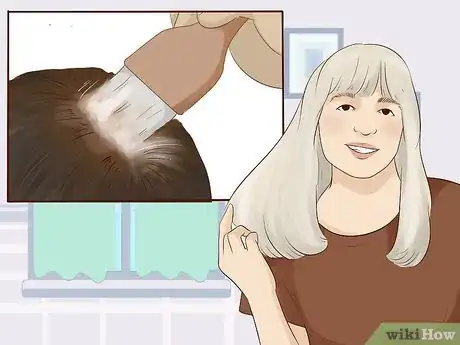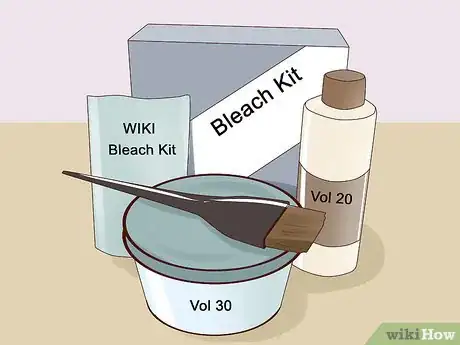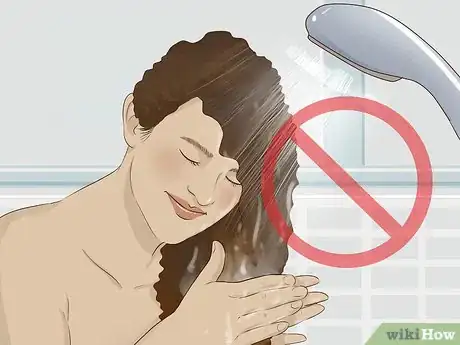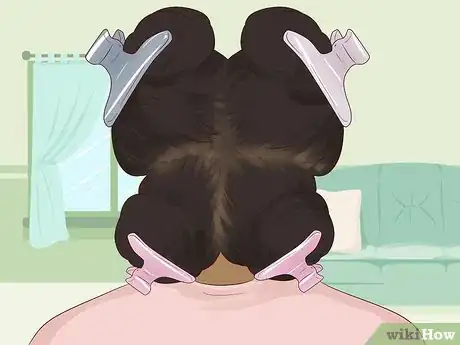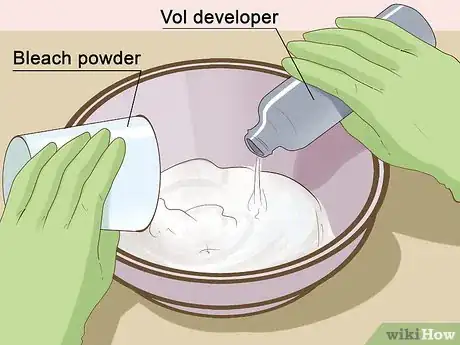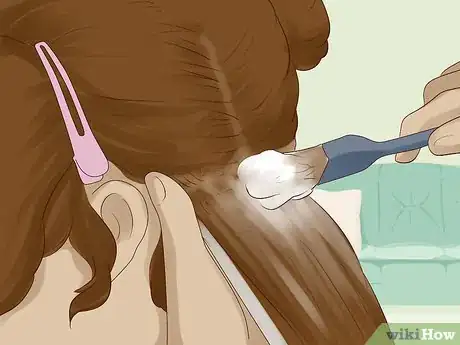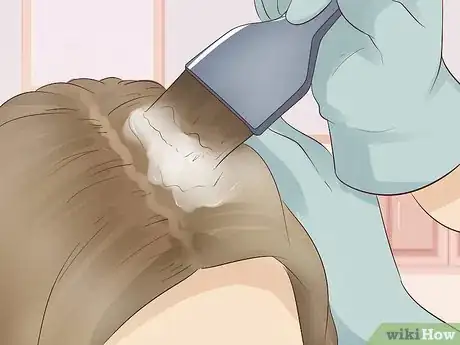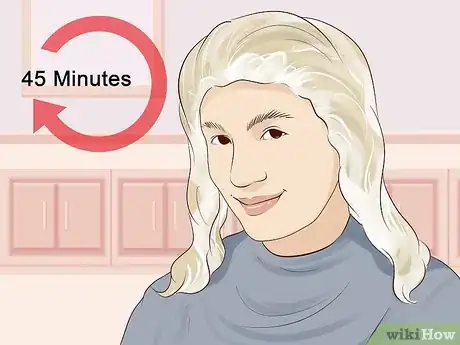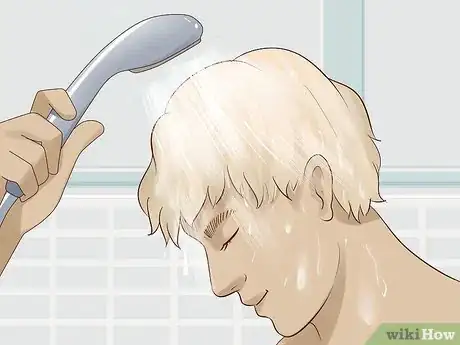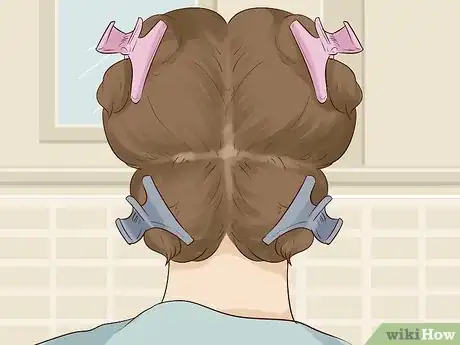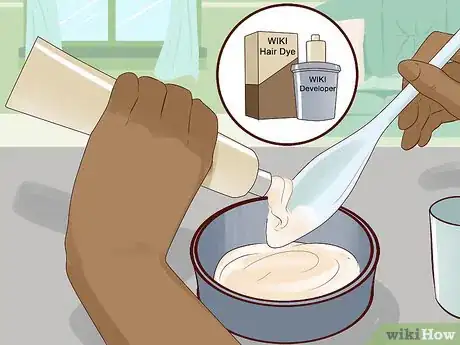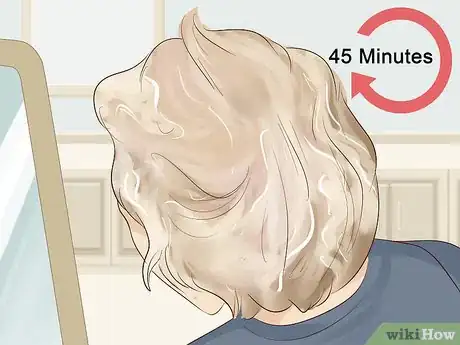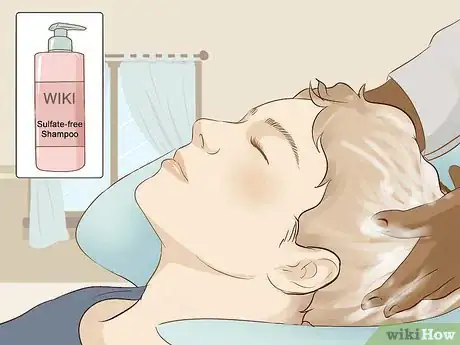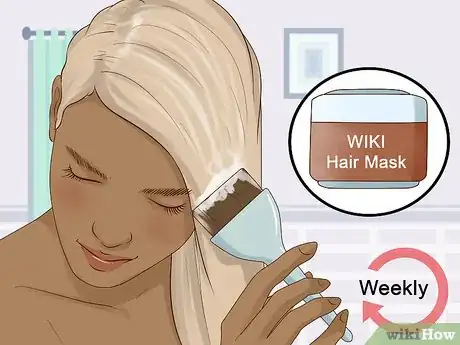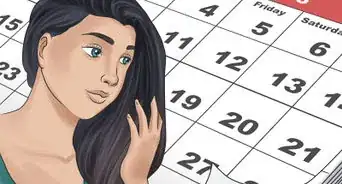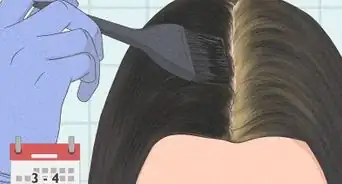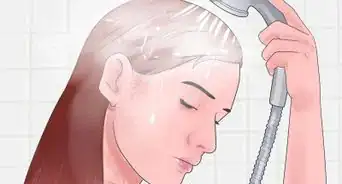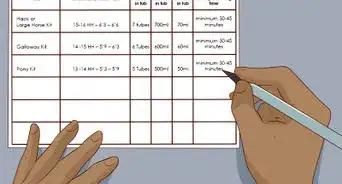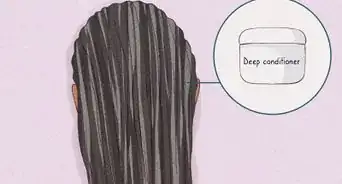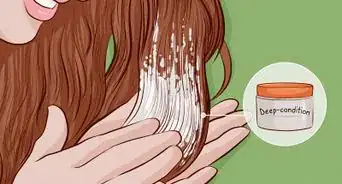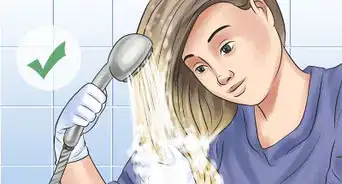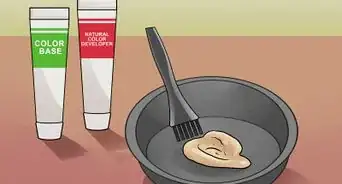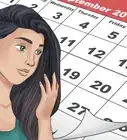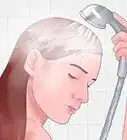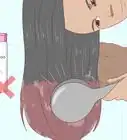This article was co-authored by Christine George and by wikiHow staff writer, Amber Crain. Christine George is a Master Hairstylist, Colorist, and Owner of Luxe Parlour, a premier boutique salon based in the Los Angeles, California area. Christine has over 23 years of hair styling and coloring experience. She specializes in customized haircuts, premium color services, balayage expertise, classic highlights, and color correction. She received her cosmetology degree from the Newberry School of Beauty.
This article has been viewed 315,450 times.
Changing your hair color is a great way to revamp your look! Dyeing hair a darker color is pretty straightforward, but if you want to dye your hair lighter than it currently is, you will probably need to bleach it first. Apply your chosen hair color to damp hair right after rinsing the bleach out. Don't forget to maintain your new color by deep-conditioning your hair weekly and keeping shampooing to a minimum!
Steps
Bleaching Your Hair
-
1Bleach your hair first if you have black or previously dyed hair. If you fall into one of these categories, there’s no getting around pre-lightening with bleach before going lighter. If you have virgin hair, you can usually go a few shades lighter with a high-lift boxed dye. Going from dark brown hair to blonde with hair dye alone is probably unrealistic, but you can definitely lighten up virgin hair without bleach.[1]
- For example, if you have light brown hair that’s never been dyed, you can dye it blonde without using bleach.
- If you have dark brown virgin hair, you can dye it light brown or red without using bleach. Buy the dye that depicts the hair color you want to achieve on the box; you don't need to amend anything to account for darker hair as long as it's virgin.
-
2Purchase a vol 20 or 30 bleach kit from a beauty supply store. If you have red, light brown, or medium brown hair, use vol 20 developer. If you have black or dark brown hair, use vol 30 developer. If you aren’t sure, err on the side of caution and get the lower vol 20 developer. You can always bleach again if you need to![2]
- Avoid vol 40 developer, which is the strongest developer available. It’s too harsh to use all over your head and is typically used by professional stylists or for highlighting small sections of hair.
Advertisement -
3Avoid washing your hair for several days before you bleach. Bleach can irritate and even burn your scalp, but the natural oils that build up when you don’t wash it can add a layer of protection. At minimum, avoid washing for 48 hours before bleaching. You may also want to do several conditioning masks in the 2 weeks prior to bleaching to minimize damage and breakage.[3]
- Go with intensely hydrating masks and conditioners with nourishing ingredients like shea butter and Argan oil.
-
4Divide your hair into 4 sections. Part your hair down the center, vertically, from the crown to the nape of your neck. Then divide those sections in half, horizontally, from ear to ear. Clip each section in place on top of your head with a plastic hair clip.[4]
- Don't use metal clips when you're bleaching your hair.
- Dividing your hair into 4 manageable quadrants makes the bleaching process easier and helps to ensure the color is stripped evenly.
-
5Mix the bleach powder and vol developer together in a large bowl. Your bleach kit will contain both powder and developer, as well as an applicator and pair of plastic gloves. Put on the gloves and an old-t-shirt before you start mixing. Then, measure and pour both ingredients into a bowl. Mix them together until they’re thoroughly incorporated.[5]
- Make sure you follow the mixing directions on the packaging. You may need to combine them in a ratio of 1:1 or 1:2.
- Use the bleach immediately after mixing it.
- At this point, drape a towel around your shoulders to protect your skin during the process. You can also add a swipe of petroleum jelly along your hairline to protect the skin around your forehead and face.
-
6Use the applicator to apply the bleach to the first section of hair. Start with the bottom sections before moving on to the top ones. As you work, separate each section into several smaller sections. Remove the clip to release the first section of hair, section it, and use the applicator brush that came with your kit to apply the bleach mixture onto each section from root to tip. Get as close to the roots as possible without touching your scalp.
- Once the section is saturated with the mixture, clip it back up and out of the way.
- Work as quickly as you can, since the bleach mixture loses strength the longer it sits out. The bleach will still work if you let it sit out for a few hours, but it will take longer to process your hair and generally be less effective.
- Dividing your hair into smaller sections will help you evenly apply the bleach. If your hair is thick, it's especially important that you make many small sections.
-
7Saturate the remaining 3 sections of hair with the bleach mixture. Unclip the next section and apply the bleach mixture from root to tip. Clip it back up and continue the same process until all 4 sections are thoroughly saturated. Try to apply the bleach in thin layers to small areas at a time so that all of your hair gets coated evenly.[6]
-
8Let the bleach sit on your hair for the suggested amount of time. Check the bleach kit packaging for instructions about timing. In general, the darker your hair is, the longer the bleach mixture should sit on your hair. 30 to 45 minutes is pretty typical.[7]
- You can put a clear, plastic cap over your hair while it processes. This helps control the bleach so it's less messy. Also, the cap traps in your head's natural heat.
- Be sure to check your progress every 5 to 10 minutes to avoid over-processing your hair.
- Never leave bleach on your hair for longer than 1 hour.
-
9Rinse out the bleach thoroughly with cold water. The cold water stops the bleach from processing your hair, so try to rinse quickly and thoroughly for even results. Follow the rinse up by shampooing your hair twice in a row, rinsing thoroughly with cold water in between, to make sure you remove all of the bleach.[8]
Applying the Hair Dye
-
1Divide your hair into 4 sections. The process for applying hair dye is pretty similar to the bleaching process. Divide your hair into 4 sections, just like you did before bleaching, and clip those sections out of the way. Put on a fresh pair of protective gloves and drape a towel around your shoulders to protect your clothing and skin from being stained by the dye.[9]
- To prevent staining on your forehead and face, smear a little petroleum jelly along your hairline.
-
2Mix your chosen hair dye according to the package directions. Your boxed dye kit will come with a few liquid-filled bottles and instructions on how to mix them together, so follow the package directions. Every brand will be a little different, so read the instructions carefully.[10]
-
3Apply the dye mixture to the first section of hair. As you apply the dye, separate each section of hair into smaller sections. Use the applicator that came with the dye to brush the mixture onto damp hair from root to tip. Be sure to saturate your hair thoroughly and evenly with the dye. Clip the hair out of the way and unclip the next section.[11]
- Smaller sections make it easier to completely saturate your hair.
- Continue in the same way until all of your hair is saturated with the hair dye.
-
4Let the dye sit on your hair for the specified amount of time. Each brand will be different, but a processing time of 30 to 45 minutes is typical for hair dye. Check the package instructions for specifics. Set a timer to alert you when the time is up, just in case you forget![12]
-
5Rinse the dye out of your hair with cool water. Be sure to rinse your hair thoroughly until the water runs clear. Your boxed dye kit should include a tube of intensely hydrating conditioner to apply from root to tip right after you rinse out the dye. Let the conditioner saturate your hair for about 5 minutes, then rinse it out thoroughly with cool water.[13]
- Cool water seals your cuticle so your hair looks shinier. Also, a sealed cuticle cuts down on frizz. Additionally, hot or warm water may strip the fresh color out of your hair.
- Don’t shampoo your hair before you condition it, since this will strip the fresh color out of your hair. Don’t shampoo your hair for at least 24 hours.
- If your dye kit didn't come with conditioner, use a regular deep conditioner.
Maintaining Your New Hair Color
-
1Keep shampooing to a minimum to prevent color fading. Hair color fades a small amount each time you wash it. Try to go a few days in between washings for the best color retention. If your hair gets oily fast, try using a dry shampoo on your off days.
- When you do shampoo, avoid clarifying products and opt for sulfate-free shampoos and conditioners to protect your color.
- Look for shampoos, conditioners, and other hair products formulated for use on color-treated hair.
-
2Use a blue or purple color correcting shampoo if you experience brassiness. The lighter you dyed your hair, the more prone it will be to brassy yellow or orange tones over time. You can keep brassiness at bay with a color correcting shampoo purchased from a beauty supply store. Purple shampoos counteract yellow tones and blue shampoos counteract orange tones.[14]
- You may be able to use the color correcting shampoo every time you wash your hair, but check the product directions to make sure.
-
3Deep-condition your hair weekly to keep it looking healthy. After bleaching your hair, it will probably feel pretty dry and brittle. You may even experience some damage and breakage, all of which is totally normal. The best way to combat these issues is to use a weekly deep-conditioner to restore hydration and nutrients to your hair.[15]
- Hair masks are also great for restoring moisture.
Expert Q&A
Did you know you can get expert answers for this article?
Unlock expert answers by supporting wikiHow
-
QuestionHow do you lighten dyed dark brown hair?
 Christine GeorgeChristine George is a Master Hairstylist, Colorist, and Owner of Luxe Parlour, a premier boutique salon based in the Los Angeles, California area. Christine has over 23 years of hair styling and coloring experience. She specializes in customized haircuts, premium color services, balayage expertise, classic highlights, and color correction. She received her cosmetology degree from the Newberry School of Beauty.
Christine GeorgeChristine George is a Master Hairstylist, Colorist, and Owner of Luxe Parlour, a premier boutique salon based in the Los Angeles, California area. Christine has over 23 years of hair styling and coloring experience. She specializes in customized haircuts, premium color services, balayage expertise, classic highlights, and color correction. She received her cosmetology degree from the Newberry School of Beauty.
Master Hair Stylist & Colorist If it is a semi-permanent dye or a demi, you can get clarifiers to help loosen up the amount of pigment that was deposited. If you have permanently dyed hair that needs to be lightened, it can be difficult to do it at home because the strength of the products you need may damage your hair if they are not used properly. I recommend seeing a professional hair stylist.
If it is a semi-permanent dye or a demi, you can get clarifiers to help loosen up the amount of pigment that was deposited. If you have permanently dyed hair that needs to be lightened, it can be difficult to do it at home because the strength of the products you need may damage your hair if they are not used properly. I recommend seeing a professional hair stylist. -
QuestionWhy should I get my hair dyed by a professional stylist?
 Christine GeorgeChristine George is a Master Hairstylist, Colorist, and Owner of Luxe Parlour, a premier boutique salon based in the Los Angeles, California area. Christine has over 23 years of hair styling and coloring experience. She specializes in customized haircuts, premium color services, balayage expertise, classic highlights, and color correction. She received her cosmetology degree from the Newberry School of Beauty.
Christine GeorgeChristine George is a Master Hairstylist, Colorist, and Owner of Luxe Parlour, a premier boutique salon based in the Los Angeles, California area. Christine has over 23 years of hair styling and coloring experience. She specializes in customized haircuts, premium color services, balayage expertise, classic highlights, and color correction. She received her cosmetology degree from the Newberry School of Beauty.
Master Hair Stylist & Colorist Permanent hair dyes can be extremely difficult to remove without professional help, as you need professional-grade color strippers and leeches to remove permanent dye. If not used properly, these can dry out your hair and damage it even further to the point in which a professional needs to step in and help you correct that.
Permanent hair dyes can be extremely difficult to remove without professional help, as you need professional-grade color strippers and leeches to remove permanent dye. If not used properly, these can dry out your hair and damage it even further to the point in which a professional needs to step in and help you correct that. -
QuestionWhat should I keep in mind when using box dye?
 Christine GeorgeChristine George is a Master Hairstylist, Colorist, and Owner of Luxe Parlour, a premier boutique salon based in the Los Angeles, California area. Christine has over 23 years of hair styling and coloring experience. She specializes in customized haircuts, premium color services, balayage expertise, classic highlights, and color correction. She received her cosmetology degree from the Newberry School of Beauty.
Christine GeorgeChristine George is a Master Hairstylist, Colorist, and Owner of Luxe Parlour, a premier boutique salon based in the Los Angeles, California area. Christine has over 23 years of hair styling and coloring experience. She specializes in customized haircuts, premium color services, balayage expertise, classic highlights, and color correction. She received her cosmetology degree from the Newberry School of Beauty.
Master Hair Stylist & Colorist The majority of our color corrections in the salon are the result of box dyes. When you dye your hair, you're balancing out a color, and if your hair is already pre-dyed, the color will appear differently on your natural roots than how it will look on the previously dyed hair. Try to look into the base color of the dye you are using and consider seeing a professional hair stylist. They will have an understanding of color theory and what colors cancel out other colors.
The majority of our color corrections in the salon are the result of box dyes. When you dye your hair, you're balancing out a color, and if your hair is already pre-dyed, the color will appear differently on your natural roots than how it will look on the previously dyed hair. Try to look into the base color of the dye you are using and consider seeing a professional hair stylist. They will have an understanding of color theory and what colors cancel out other colors.
Things You'll Need
- Bleach kit
- Boxed hair dye
- 2 pairs of gloves
- Old towels
- Large bowl
- Mixing utensil
- 2 applicator brushes
- Hair clips
- Deep conditioner or hair masks
References
- ↑ https://bellatory.com/hair/How-to-bleach-hair
- ↑ https://www.refinery29.com/how-to-bleach-hair#slide-6
- ↑ https://www.refinery29.com/how-to-bleach-hair#slide-2
- ↑ https://bellatory.com/hair/How-to-bleach-hair
- ↑ https://bellatory.com/hair/How-to-bleach-hair
- ↑ https://www.refinery29.com/how-to-bleach-hair#slide-6
- ↑ https://www.refinery29.com/how-to-bleach-hair
- ↑ https://bellatory.com/hair/How-to-bleach-hair
- ↑ https://bellatory.com/hair/How-to-dye-hair
